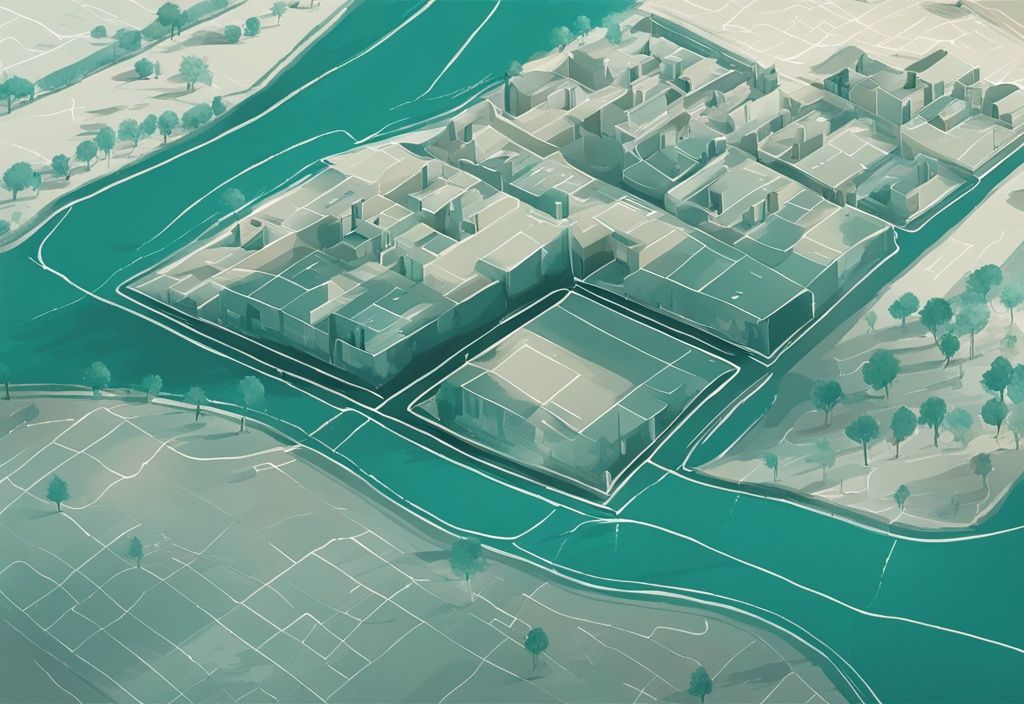Ever stumbled over the term ‘parcel’ in your real estate adventure and wondered what on Earth it meant? Let’s clear that up right away. A parcel – the unsung hero of property transactions – is absolutely vital to your buying, selling or investing journey.
This article will be your friendly guide. It will take you step-by-step through everything you need to know about what a parcel is in real estate, why it’s so damned important, and how it impacts property management. Don’t worry, we’ll keep the jargon light and the information clear.
So, are you a rookie homebuyer? Or a savvy investor? Either way, read on. Knowledge of parcels can lead to informed decisions and even, save you from some pretty nasty missteps. You clicked on this article for a reason, didn’t you? Let’s unravel the parcel mystery, shall we?
Understanding the Concept of Parcels in Real Estate
If you’re diving into the world of real estate, grasping the concept of parcels is foundational. This section unpacks what parcels in real estate are, why they’re essential, and how they impact property management and transactions.
Definition of a Parcel in Real Estate
A parcel of land is like having a well-defined piece of cake from a larger cake. This piece comes with its own unique boundaries and purposes, such as selling, leasing, or development, and can be identified by a unique Parcel Identification Number (PIN) which you can learn more about on the official Alabama State government website here. The term “parcel” has roots in the Old French word “parcelle,” which means a small piece of land. It’s identified by a parcel number or tax ID number provided by the county tax assessor, crucial for accurate property assessment.
Think of this identifier as your land’s unique ID card—it ensures accurate assessment and taxation. Beyond that, each parcel boasts intricate legal descriptions and geographic coordinates, making it unmistakable and legally sound.
Why Parcels are an Essential Aspect of Real Estate
Understanding what is a parcel in real estate is a must for property owners, investors, and homebuyers alike. It enables you to make well-informed decisions and manage property taxes wisely. Each parcel’s legal boundaries are precisely documented in deeds, which helps in avoiding disputes and misunderstandings.
Zoning laws also come into play, outlining how you can use each parcel. These laws ensure your property is used to its full potential while adhering to local regulations. Having accurate parcel information is crucial in all real estate transactions—be it buying, selling, or developing property. This precision helps comply with zoning restrictions, manage easements, and avoid encroachments.
In short, knowing the ins and outs of parcels ensures smoother, conflict-free transactions, giving you peace of mind as you navigate the world of real estate.
Key Characteristics of Real Estate Parcels
Real estate parcels have attributes that significantly influence their utility and value. Let’s break these down to understand better.
Size and Shape of Parcels
The size and shape of a parcel in real estate can vary immensely. Think of them as the building blocks of real estate, ranging from small residential lots of about one-fifth of an acre to vast commercial expanses covering several hundred acres. This variation caters to diverse real estate needs, whether you’re looking for a cozy home or a sprawling business space.
Every parcel is unique, with different shapes and sizes that can significantly impact its value and utility. To make informed decisions, it’s crucial to understand how a financial analysis in real estate is being conducted, which can offer insights into potential investments and financial outcomes.
While some parcels are neatly rectangular or square, others adapt to the landscape and specific needs, resulting in more irregular forms. Measurements of these parcels are commonly expressed in square footage or acres, essential metrics that aid in development planning and transactions.
Legal Boundaries and Identification Processes
Understanding what is a parcel in real estate also involves knowing its legal boundaries and identification processes. This is where land surveyors come into play. They use a combination of fieldwork, GPS, and satellite imagery to measure parcels accurately. Clearly established legal boundaries are crucial to avoid disputes and ensure smooth dealings with neighboring properties.
Each parcel is assigned a unique Parcel Identification Number (PIN), essential for record-keeping, tax assessments, and efficient land management. These PINs streamline administration and tracking of land parcels. Additionally, geographic coordinates mapped through GIS technology provide detailed and precise location information, enhancing accuracy and ease in managing parcels.

Diverse Types of Parcels in Real Estate
In the realm of real estate, understanding what is a parcel in real estate lays the foundation for making informed decisions, whether you’re eyeing residential plots or commercial spaces.
Residential Versus Commercial Parcels
Knowing what is a parcel in real estate is crucial when discerning between residential and commercial parcels.
Residential parcels are primarily designated for housing. These plots are shaped by zoning laws that control the type and density of housing that can be built. From cozy single-family homes to bustling apartment complexes, the goal is to foster a balanced living environment.
Families and individuals hunting for their dream home or investment property often look for these parcels. They’re perfect for building anything from a charming house to a modern duplex or townhouse.
Commercial parcels, in contrast, are geared towards business ventures. Here, location and accessibility are vital—think of them as the lifelines for retail stores, office spaces, or even industrial hubs.
Zoning laws for commercial parcels focus on aspects like business type, parking availability, and customer access. Essentially, these parcels lay the groundwork for profitable and efficient business operations.
Unique Concerns with Waterfront Parcels
Waterfront parcels are synonymous with breathtaking views and recreational activities like boating and fishing. However, they come with their own set of challenges.
Environmental regulations are often stricter for these parcels to protect natural habitats and water quality. This means a bit more homework and adherence to rules but ensures the beauty and health of the area are preserved.
Another biggie—flood risk. Waterfront areas are more prone to flooding, so you’ll need specialized construction techniques and might face higher insurance costs.
These unique considerations mean detailed due diligence and robust risk management strategies. But the payoff—a magnificent waterfront property—can be well worth it.
Importance of Parcel Identification and Mapping
How County Assessor’s Office Establish Parcel Identity
Identifying parcels accurately is vital for ensuring fair tax assessments and efficient land record management.
Local authorities like the County Assessor’s Office or Land Registry meticulously maintain parcel data. They ensure each parcel has a unique identification number, making it easier to manage and tax properties effectively. Understanding aspects like market allocation in real estate can further enhance efficiency in property management.
Parcel mapping is equally crucial, offering a visual representation of parcel boundaries.
This step is essential to prevent encroachments and disputes by clearly defining legal boundaries. With advanced tools like GIS technology, parcel boundaries are mapped using geographic coordinates, allowing for precise tracking and identification.
The Role of Accurate Parcel Information in Transactions
Understanding what a parcel is in real estate can make a world of difference in smooth property transactions. Accurate parcel information is fundamental in addressing zoning restrictions, easements, and encroachments. This ensures that all legal and zoning requirements are met, allowing both buyers and sellers to confidently move forward.
Clear parcel boundaries are critical for seamless buying, selling, and property development. Lack of clarity can lead to disputes, jeopardizing transactions and causing financial and legal headaches. Keeping parcel data up-to-date and accurate is essential for a stable and thriving real estate market.

Impact of Zoning on Parcel Usage
Parcels in real estate are significantly influenced by zoning laws. These regulations determine how different types of land are utilized—be it for residential, commercial, agricultural, or other purposes.
Understanding Zoning Classifications
Zoning classifications are like a playbook for parcel usage. Think of zoning laws as the rules that outline what kind of buildings can go where and what activities can happen on a parcel. The aim here is orderly development, ensuring incompatible types of land use aren’t situated next to one another.
You’ll encounter zoning labels like residential, commercial, and agricultural. For instance, a parcel zoned for residential use might house single-family homes or apartment complexes. On the other hand, commercial zoning paves the way for retail stores, offices, or other business ventures.
Each zoning classification shapes a parcel’s potential and market value in unique ways. Residential zones often focus on housing density and types, while commercial zones look at factors like accessibility and visibility to boost business. Agricultural zoning aims to protect farmland and regulate agricultural activities. Knowing the zoning classification of a parcel is key for property owners, investors, and developers who want to maximize the land’s value and utility.
How Zoning Laws Shape Parcel Usage
Zoning laws don’t just stop at defining what you can do on a parcel; they also influence density, building heights, and types of permitted activities. For example, density regulations might dictate how many housing units can be built per acre, shaping the character of neighborhoods significantly.
Height restrictions might come into play to preserve sightlines and maintain the aesthetic vibes of an area, particularly in residential or historic zones.
Moreover, zoning laws specify permissible usage types. These can be residential, commercial, industrial, or special-purpose uses. By enforcing these rules, local governments aim to ensure that parcels are developed in a manner that aligns with the community’s goals and minimizes conflicts.
Following local zoning laws is crucial for any development project. Unauthorized uses or violations can lead to penalties, delays, and costly adjustments. Being well-versed and compliant with zoning laws can streamline project approvals and contribute to long-term success in land-use planning.
Navigating Real Estate Transactions Involving Parcels
Steps in Buying and Selling Parcels
Understanding what is a parcel in real estate is essential for any transaction involving land. Each step in the process ensures clarity, legality, and smoothness from beginning to end.
First up, identifying the parcel is crucial. It’s like getting to know your plot of land through a unique identification number and a legal description. This helps in clearly defining the property’s boundaries and features. Both buyers and sellers need to grasp these details.
Next, we have the detailed survey. Think of this as the land’s health check-up. Measuring the land to determine its exact boundaries and features helps prevent future disputes and lays down a clear understanding of the parcel’s layout and potential.
Now, performing due diligence is pivotal. This step ensures the parcel has a clear title and adheres to zoning regulations. Consider this as clearing any legal or regulatory speed bumps that might affect the deal.
Finally, the actual transaction kicks off. Here, working with real estate agents and legal pros is key. These experts help finalize everything, from preparing to correctly signing legal documents, making sure the ownership transfer is as smooth as silk.
Significance of Title Search in Parcel Transactions
A title search in real estate is akin to a deep-dive background check for your parcel. It verifies the legal ownership, scrutinizing public records to ensure the parcel is free of liens, disputes, or legal hurdles.
Having a clear title is a non-negotiable as it guarantees the buyer won’t face legal issues post-purchase. It’s all about securing peace of mind for both parties, ensuring ownership is undisputed and the transaction is rock-solid.

FAQs: Getting Familiar with Parcels
How does a parcel differ from a lot?
A parcel, in real estate lingo, is a broader term that can encompass multiple lots. Think of it like this: a parcel can include various chunks of land under one division, while a lot typically refers to a smaller, singular piece of land often meant for homes. Understanding what a parcel in real estate encompasses is essential to grasp the various subdivisions within a larger property and their potential uses.
Imagine a parcel as a big family. Within this family, there can be many individual members, each with its own unique identity. These members are the lots. They can live harmoniously under the same name (the parcel) but have distinct roles.
How is a parcel identified for tax purposes?
For tax purposes, each parcel gets a unique parcel number or tax ID number assigned by the County Assessor’s Office. This ID is crucial for gauging property taxes and keeping accurate records.
Knowing what a parcel in real estate entails ensures that you stay on top of local tax requirements and can keep accurate tabs on the property’s tax responsibilities. It’s like having a social security number for your land—it identifies it uniquely and keeps everything in check.
Can a single parcel contain multiple lots?
Absolutely, a single parcel can house multiple lots, and these lots don’t necessarily need to be next to each other. Imagine a big quilt made of different patches. Each patch represents a lot that can be independently bought or sold.
However, all transactions involving these lots must be coordinated with the county tax assessor’s office. Understanding this concept is vital to grasping what a parcel in real estate is and how multiple distinct properties can exist within a single, larger boundary.
Conclusion
Understanding the complexities of parcels in real estate is crucial for various stakeholders like property owners, investors, and developers. Think of a parcel as an officially separated portion of land. It plays a significant role in real estate transactions and planning.
The accurate identification of parcels, often through a unique parcel number or tax ID, allows for precise tracking and management. This precision eliminates confusion and ensures smooth real estate transactions. Imagine it as having a unique fingerprint for each piece of land—everything is much easier to track and manage when each parcel has its own distinct identity.
Legal boundaries are another vital aspect of parcels in real estate. These boundaries, clearly defined and surveyed through sophisticated methods such as GPS and satellite imagery, prevent disputes and encroachments that could otherwise complicate property ownership and transactions.
These legal definitions ensure that everyone—from the property owner to local authorities—knows the exact extent of a piece of land. This precision is invaluable, especially in real estate development and property sales. It’s like marking your territory to prevent any misunderstandings later.
Compliance with zoning laws further ensures that parcels are used maximally and legally. Zoning laws, which delineate how a parcel can and cannot be used, play a substantial role in the value and potential of a piece of land. They dictate the types of buildings allowed, their density, and other critical developmental parameters.
Adhering to these laws is not just a matter of legality but is essential for the strategic development and optimization of land use. Think of zoning laws as the rulebook for your land—it ensures you’re making the most out of your property, legally and efficiently.
Hi, I’m Alex Harper, a real estate expert with over ten years of experience in property management and legal advice. My passion is making the often complicated world of real estate understandable. I share practical tips and simple solutions to help you make better decisions – whether you’re buying a home, renting or just want to learn more about the industry. With my knowledge and experience, I want you to feel well-informed and confident in your real estate projects. Let’s tackle this together!




